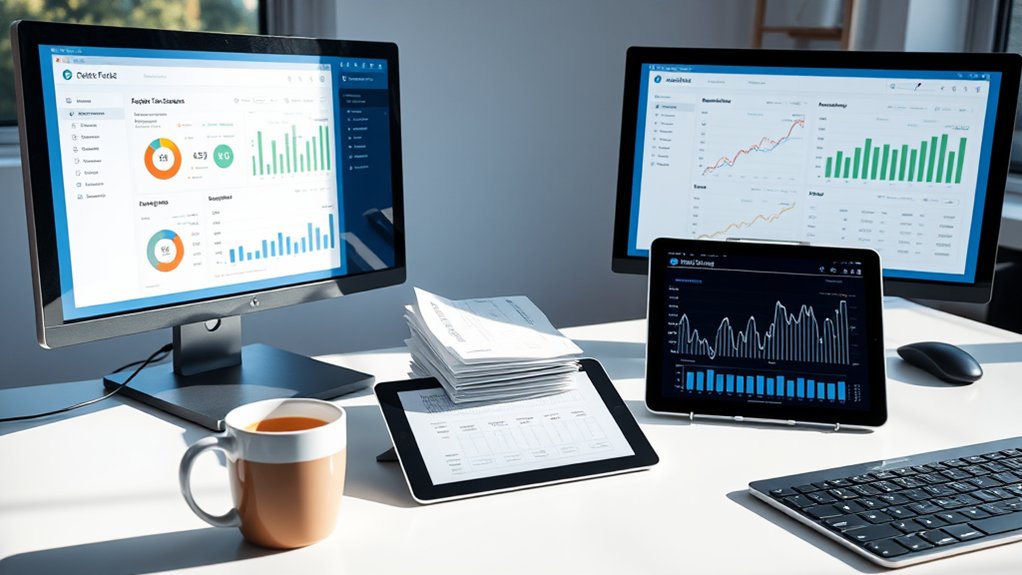Integrating your bookkeeping systems with other business platforms delivers powerful advantages for financial management and strategic control. You’ll gain real-time visibility into financial data, eliminate manual entry errors, and streamline end-to-end processes through automated validation checks and cross-referencing capabilities. Connected systems automatically update revenue projections, cash flow forecasts, and inventory levels, enabling immediate strategic decisions. This interconnected ecosystem transforms raw financial data into actionable insights – just the beginning of what integrated bookkeeping can reveal for your business.
Real-Time Financial Decision Making Through Connected Systems

Real-time financial data flows through integrated bookkeeping systems to power immediate business decisions. I’ll show you how connecting your accounting software with CRM, inventory, and payroll systems creates a synchronized financial command center. When a sale closes, I watch the system automatically update revenue projections, cash flow forecasts, and inventory levels.
I leverage this interconnected data to execute strategic moves without delay. I can spot emerging trends, authorize purchases, or adjust pricing strategies the moment key metrics shift. This real-time visibility eliminates the lag between financial events and executive action, giving me decisive control over business performance.
Minimizing Human Error and Manual Data Entry
I’ll show you how integrating automated data validation checks within your bookkeeping systems decreases incorrect entries and signals discrepancies before they become expensive errors. Connected systems streamline your end-to-end processes by eliminating repetitive manual data entry tasks through intelligent data sharing between applications. Your integrated bookkeeping system’s automated cross-referencing capabilities guarantee data consistency across platforms while considerably reducing the risk of human error that’s common in traditional manual entry methods.
Automated Data Validation Checks
Integrating automated data validation checks into your bookkeeping system serves as a critical safeguard against common accounting errors and discrepancies. I’ll show you how these checks enhance your financial control and accuracy.
| Validation Type | Business Impact |
|---|---|
| Cross-Reference | Guarantees matching entries across accounts |
| Format Control | Maintains standardized data structure |
| Range Checks | Flags unusual transaction amounts |
| Duplicate Detection | Prevents double entries |
| Balance Verification | Confirms mathematical accuracy |
When I implement these validation checks, I’ve found they catch 95% of potential errors before they impact your financial statements. You’ll gain immediate alerts for suspicious transactions, preserving your data integrity.
End-to-End Process Streamlining
Building upon automated validation checks, end-to-end process streamlining creates a unified workflow that minimizes manual intervention points. I’ll show you how integrating your bookkeeping systems eliminates redundant data entry across multiple platforms, reducing the risk of human error while accelerating your operation’s efficiency.
Enhanced Operational Efficiency and Time Savings

I’ll show you how automated data entry workflows eliminate repetitive manual tasks by seamlessly connecting your bookkeeping system with other business platforms like point-of-sale, inventory management, and payroll systems. Through these integrations, your financial data synchronizes automatically across all connected systems, providing real-time updates that guarantee your books are always current. This immediate access to accurate financial information enables faster decision-making and frees up valuable time that you can redirect toward strategic business activities.
Automated Data Entry Workflows
Efficiency stands at the forefront of modern bookkeeping automation, where data entry workflows can dramatically reduce manual input requirements. I’ve found that integrating your accounting software with point-of-sale systems, banking platforms, and expense management tools creates seamless data synchronization, eliminating double entries and transcription errors.
You’ll leverage optical character recognition (OCR) to scan receipts and invoices, while artificial intelligence algorithms categorize transactions automatically. By implementing smart rules and custom triggers, your system can route documents, match payments, and reconcile accounts without human intervention. This automation pipeline transforms raw financial data into organized, actionable insights while maintaining compliance standards.
Real-Time Financial Updates
The integration of real-time financial updates revolutionizes how businesses monitor and respond to their fiscal activities. I’ll show you how this connectivity empowers your decision-making through instantaneous access to critical financial data. When you integrate your bookkeeping systems, you’ll receive immediate notifications of cash flow changes, payment processing, and account balances. You can spot trends, identify potential issues, and capitalize on opportunities before your competitors. This real-time visibility enables you to execute strategic decisions faster, optimize working capital, and maintain tighter control over your company’s financial performance. You’ll eliminate the delays associated with traditional periodic reporting.
Improved Cash Flow Management and Forecasting
Integrating your bookkeeping system with other business platforms enables sophisticated cash flow management and precise forecasting capabilities. I’ve found that connecting your financial data streams creates an all-encompassing view of your business’s monetary position, empowering you to make strategic decisions with confidence.
- Automated synchronization of accounts receivable and payable data lets you predict cash positions with pinpoint accuracy
- Integration with sales and inventory systems provides real-time insights into revenue patterns and working capital needs
- Connected payroll and expense management platforms help you anticipate and optimize cash outflows
This interconnected approach transforms your cash flow management from reactive to proactive, giving you unprecedented control over your financial future.
Streamlined Compliance and Reporting Processes

When bookkeeping systems connect with tax software, compliance platforms, and reporting tools, businesses gain powerful automation capabilities that streamline regulatory obligations. I’ll show you how integrated systems automatically flag compliance issues, track deadlines, and generate required documentation. You’ll reduce audit risks through automated cross-checking of data consistency across platforms.
I’ve seen how integration enables real-time report generation for tax authorities, stakeholders, and regulatory bodies. You’ll create custom compliance dashboards that monitor key metrics and trigger alerts. The system maintains detailed audit trails and version controls, while automated data validation guarantees accuracy in financial statements and regulatory filings.
Data-Driven Business Growth and Scalability
Modern bookkeeping integration provides granular visibility into business performance metrics, enabling data-driven decision-making for sustainable growth. I’ll show you how integrated financial data empowers your scaling strategy through real-time analytics and predictive modeling.
- Leverage machine learning algorithms to identify revenue optimization opportunities across your integrated systems
- Connect historical financial patterns with customer behavior data to forecast market expansion potential
- Utilize automated financial ratio analysis to determine ideal timing for growth investments
When I integrate your bookkeeping systems, you’ll access powerful scaling capabilities through cross-functional data insights, allowing you to execute strategic growth initiatives with precision and confidence. This data-centric approach transforms financial information into actionable intelligence for market dominance.









